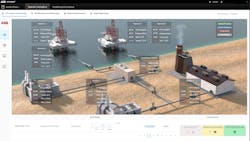Digital twin simulators helping carbon capture operators to safeguard their networks
Editor's note: This feature article first appeared in the November-December 2023 issue of Offshore magazine. Click here to view the full issue.
By Jeremy Beckman, Editor-Europe
CARBON CAPTURE AND STORAGE (CCS) is moving closer to widespread deployment, as developers finalize long-term CO2 offtake arrangements with multiple industrial groups. Norway’s trailblazing Northern Lights project, due to start injection in the North Sea next year, will be the world’s first to collect and transport CO2 emitted by diverse industries for permanent storage in a subsea reservoir. Similar developments should follow across the wider North Sea region later this decade, with further onshore/offshore schemes under review in Western Australia, South-East Asia and the southern US.
But while the commercial arrangements are slotting into place, the process of safely managing large quantities of CO2 with different compositions at all times through a purpose-built transportation, injection and subsurface network is a leap into the unknown. A new partnership led by ABB is looking to address these concerns, at the same time helping would-be CCS developers reduce the capital and operating costs of their projects. Collectively, ABB, Pace CCS and Computer Modelling Group (CMG) will apply digital twin technology to simulate, design and test scenarios to deliver proof of concept for a planned CCS facility or process, with surface and subsurface modeling and analysis continuing through the operations phase.
According to Nigel Greatorex, Global Industry Manager of CCS at ABB, “Pace is a global subject matter specialist in the design of CCS networks, from the CO2 source where it is captured to the point of sequestration. That includes common infrastructure, pipeline, midstream boosting, heating and cooling down to the sea floor. Pace had also started to develop a digital twin designed to support proof of concept for a surface CCS network, which ABB has since acquired. This gives the client access to a digital replica of that network, confirming that the design fits the operation, while also equipping the operator with different scenarios of operation.”
In September, Calgary-based CMG came onboard, signing a contract with ABB to contribute its simulation technology for monitoring of the CO2 in the subsurface formation, whether a depleted gas reservoir or a saline aquifer. CMG is a software and consulting company specializing in reservoir modeling and production simulation, partnering with energy companies globally. The company began addressing the emerging needs of carbon capture sector over 20 years ago. According to David Hicks, vp Eastern Hemisphere, “many companies are deploying CMG’s GEM reservoir simulator for their carbon capture reservoir modeling, and most of the current CCS developers in the UK and South-east Asia use the company’s software for their subsurface studies.”
Pace’s digital twin and CMG’s software have both already been deployed (separately) in CCS projects. “To date one of the biggest challenges to the mainstream adoption of CCS has been a lack of operational practice across the full value chain,” said Pace’s CEO Matt Healey. “There is still a reluctance to make the investment without clear knowledge of how things will work on the ground, at every stage of the process.”
DIGITAL TOOLSET
The aim of these two partnerships, Greatorex explained, is to provide CCS developers with digital solutions that give them the confidence they require concerning operability of their networks. “ABB is seeking to use the two models to create a holistic digital tool set that can guide operators on different conditions. Both will be deployed in the design phase. CMG’s model shows how much CO2 can be stored subsurface, and the surface model – owned by ABB – allows the operator to develop an operating philosophy and parameters around a huge variety of situations.”
“With CO2 feeding through the network from multiple emitters, there is potential for transient plant trips. When transients do come in, it is imperative to maintain a steady state for injectivity of CO2, which has a phased operating envelope. CO2 may enter the wellbore in the dense phase and then transition back to gas in the reservoir (phase change) which can lead to operational issues. At a design level, capture accounts for the biggest cost in a CCS project. The CO2 always comes with impurities, which add risk. For example, when H20 and certain impurities combine they can form strong acids resulting in very high rates of corrosion within weeks.”
Through understanding the fluid composition, Greatorex added, a digital twin can be developed that takes into account these impurities to guide operators against integrity breaches. Once a CCS operator has good operability of the network, they can then look to optimize the amount of power needed for compression, cooling and heating. “This is important because energy is not always easy to access on a CCS network. There may not be a source of power at the point of injection or the midpoint of a pipeline, or even excess power at the capture source. By deploying a digital twin, operators can be sure the plant is not over-compressing or overheating, resulting in significant cost savings.”
ABB and Pace’s digital twin technology provides a virtual replica of a physical CCS process or facility. “Simulating the design stage and test scenarios to deliver proof of concept gives users peace of mind that the system design is fit for purpose,” Greatorex said. “The twin models the full value chain of a CCS system, a task beyond the capability of a normal control system. ABB will provide software solutions for all stages of the CCS project, from design through to operations and maintenance. During the design phase a suite of software tools and systems will simulate the power system for efficiency and stability. In the operations phase, ABB will facilitate control of the CCS system.
“Pace designs the surface element of a CCS network and can deliver ABB’s digital twin as a proof of concept for that design, allowing developers to robustly test their operating philosophy and prepare their individual operators for running the process. Once a project becomes operational, ABB deploys its full-chain digital service which draws on the experience of Pace and CMG to set up the surface and sub-surface models respectively. ABB can also supply the sensors that measure and provide inputs to the control system, which are based on industrial standards using 4-20mA in most cases. The control system then communicates this data to ABB’s CCS solution for feedthrough into the process models.”
STORAGE MANAGEMENT
For would-be CCS operators, the first exercise when embarking on a development should be to identify the available subsurface capacity, Greatorex suggested. “If you don’t know how much CO2 you can store, how can you start negotiations with users? Hence the need for a subsurface simulation model from the outset.”
Injectivity is the other overriding priority, said Hicks. “Operators should be asking themselves; can I even get the CO2 into the reservoir to start with? Even with massive storage capacity, a project won’t work without injectivity, which is a significant risk to the participants feeding through CO2. During the course of a CCS development the need may arise to drill additional wells to add to injectivity and storage capacity.
“To help the operator determine how many wells, where to drill them and how they will operate, the subsurface solution for the saline aquifer or depleted reservoir must consider the geomechanics, geochemistry, potential salting out of the near well bore caused by in-situ brine, and reservoir pressure-induced phase change. When CO2 injection is initiated the start-off pressure may be 400 psi [27.57 bar] and CO2 will be gaseous; later, as injection pressures increase above around 1,000 psi [68.95 bar], the CO2 changes to liquid form. The GEM simulator uniquely assesses the CO2 any time there is a change of pressure and temperature.”
“With all the inherent risks involved in CCS projects,” Greatorex added, “developers cannot afford to have knowledge gaps. From the emitter’s point of entry to subsurface storage there should be no surprises. If someone can provide a comprehensive package of software consultancy and simulation solutions, that gives them more confidence in the overall integrity of their CCS network.
“For the operators, the most important element is operability and availability – the network can only operate when there is stability in the system. Deploying this distributed solution using digital twins, which allows for variables, we can fine-tune the model to ensure optimization and availability. If the operator is pursuing energy reduction, this could involve a study of a large compressor, cooling down of the compressor, or when to have the heater on and off: all are high consumers of energy. The model can be used to push the operating envelope, while at the same time determining the phase the CO2 needs to be at, to reduce energy costs.”
About the Author
Jeremy Beckman
Editor, Europe
Jeremy Beckman has been Editor Europe, Offshore since 1992. Prior to joining Offshore he was a freelance journalist for eight years, working for a variety of electronics, computing and scientific journals in the UK. He regularly writes news columns on trends and events both in the NW Europe offshore region and globally. He also writes features on developments and technology in exploration and production.


